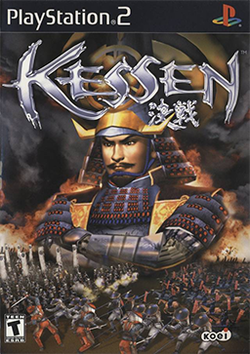Kessen
| Kessen | |
|---|---|

Cover art
|
|
| Developer(s) | Koei |
| Publisher(s) | Koei (JP) Electronic Arts (NA) |
| Director(s) | Fumito Kozutsumi |
| Designer(s) | Tachiki Kanda Norimitsu Komine Fumito Kozutsumi Takao Sakai Masahiko Sugahara Yōichi Wada Ichiro Yasuda |
| Platform(s) | PlayStation 2, PlayStation Network |
| Release date(s) |
PlayStation 2 PlayStation Network
|
| Genre(s) | Real-time tactics |
| Mode(s) | Single-player |
| Aggregate score | |
|---|---|
| Aggregator | Score |
| Metacritic | 75/100 |
| Review scores | |
| Publication | Score |
| AllGame | |
| Edge | 7/10 |
| Famitsu | 32/40 |
| GameFan | 82% |
| Game Informer | 8/10 |
| GamePro | |
| Game Revolution | B |
| GameSpot | 7.4/10 |
| GameSpy | 88% |
| IGN | 8.1/10 |
| OPM (US) | |
| Playboy | 75% |
Kessen (決戦?, "Final battle") is a real-time tactics video game produced by Koei and published by Electronic Arts. It was a launch game for the PlayStation 2 in Japan, and was released a few weeks after the system's launch in North America. It was initially the only real-time wargame game available for the PlayStation 2.
It is a real-time tactics game set in feudal Japan, focusing upon a conflict between the eastern Tokugawa clan and western Toyotomi clan (with Ishida Mitsunari as the Toyotomi's guardian and protector) shogunates at the end of Sengoku Jidai. Tokugawa Ieyasu served as the primary representative for the Eastern forces where the Western army changed leaders based on the results of select key battles.
Although it was, for the most part, historically accurate, the game contained a number of "what-if" scenarios, for example, if the Western forces are victorious at the Battle of Sekigahara (historically an Eastern victory).
Two sequels were later created, Kessen II and Kessen III. These two games introduced magical and meteorological elements to the games.
A note from the game's producer, Kou Shibusawa, addressed to players before any campaign begins, explains his desire to take his own twist on this segment of history but felt too constricted by cinema to do so properly. With Kessen, he believes that he was able to explore his ideas more freely. Thus, several of the game's cut scenes have a theatrical feel similar to chanbara and jidaigeki films.
...
Wikipedia
